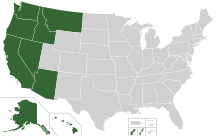United States Court of Appeals for the Ninth Circuit
| United States Court of Appeals for the Ninth Circuit | |
|---|---|
| (9th Cir.) | |
 | |
 | |
| Location | James R. Browning U.S. Court of Appeals Building |
| Appeals from |
|
| Established | March 3, 1891 |
| Judges | 29 |
| Circuit Justice | Elena Kagan |
| Chief Judge | Sidney R. Thomas |
| www | |
The United States Court of Appeals for the Ninth Circuit (in case citations, 9th Cir.) is the largest of the 13 appeals courts in the United States's federal court system. It hears cases from federal trials courts in nine western states and two Pacific Island jurisdictions.[1]
The 9th circuit[change | change source]
It is a U.S. Federal court with appellate jurisdiction over the district courts in the following districts:
- District of Alaska
- District of Arizona
- Central District of California
- Eastern District of California
- Northern District of California
- Southern District of California
- District of Hawaii
- District of Idaho
- District of Montana
- District of Nevada
- District of Oregon
- Eastern District of Washington
- Western District of Washington
It also has appellate jurisdiction over the following territorial courts:
Headquartered in San Francisco, California, the Ninth Circuit is by far the largest of the thirteen courts of appeals, with 29 active judgeships. The court's regular meeting places are in Seattle, Portland, San Francisco and Pasadena. Panels of the court occasionally travel to hear cases in other locations within the circuit. Although the judges travel around the circuit, the court arranges its hearings so that cases from the northern region of the circuit are heard in Seattle or Portland, cases from southern California are heard in Pasadena, and cases from northern California, Nevada, Arizona, and Hawaii are heard in San Francisco. For lawyers who must come and present their cases to the court in person, this administrative grouping of cases helps to reduce the time and cost of travel.
History and background[change | change source]

| Year | Jurisdiction | Total population | Pop. as % of nat'l pop. | Number of active judgeships |
|---|---|---|---|---|
| 1891 | California, Idaho, Montana, Nevada, Oregon, Washington | 2,087,000 | 3.3% | 2 |
| 1900 | Territory of Hawaii added | 2,798,000 | 3.7% | 3 |
| 1920 | Arizona added | 7,415,000 | 6.7% | 3 |
| 1940 | 11,881,000 | 9.0% | 7 | |
| 1960 | Alaska and Guam added | 22,607,000 | 12.6% | 9 |
| 1980 | Northern Mariana Islands added | 37,170,000 | 16.4% | 23 |
| 2000 | 54,575,000 | 19.3% | 28 | |
| 2007 | 60,400,000 | 19.9% | 28 | |
| 2009 | 61,403,307 | 19.72% | 29 |
The large size of the current court is due to the fact that both the population of the western states and the geographic jurisdiction of the Ninth Circuit have increased dramatically since the U.S. Congress created the United States Court of Appeals for the Ninth Circuit in 1891. The court was originally granted appellate jurisdiction over federal district courts in California, Idaho, Montana, Nevada, Oregon, and Washington. As new states and territories were added to the federal judicial hierarchy in the twentieth century, many of those in the West were placed in the Ninth Circuit: the newly acquired Territory of Hawaii in 1900, Arizona upon its admission to the Union in 1912, the Territory of Alaska in 1948, Guam in 1951, and the Commonwealth of the Northern Mariana Islands in 1977.
The Ninth Circuit also had jurisdiction over certain American interests in China.[a][2]
The Philippines were never under the Ninth Circuit's jurisdiction. Congress never created a federal district court in the Philippines from which the Ninth Circuit could hear appeals. Instead, appeals from the Supreme Court of the Philippines were taken directly to the Supreme Court of the United States.[b]
In 1979, the Ninth Circuit became the first federal judicial circuit to set up a Bankruptcy Appellate Panel as authorized by the Bankruptcy Reform Act of 1978.

The cultural and political jurisdiction of the Ninth Circuit is just as varied as the land within its geographical borders. In a dissenting opinion in a rights of publicity case involving the Wheel of Fortune star Vanna White, Circuit Judge Alex Kozinski sardonically noted that "[f]or better or worse, we are the Court of Appeals for the Hollywood Circuit."[3] Judges from more remote parts of the circuit note the contrast between legal issues confronted by populous states such as California and those confronted by rural states such as Alaska, Idaho, Montana, and Nevada.
Judge Andrew J. Kleinfeld, who maintains his judicial chambers in Fairbanks, Alaska, wrote in a letter in 1998: "Much federal law is not national in scope....It is easy to make a mistake construing these laws when unfamiliar with them, as we often are, or not interpreting them regularly, as we never do."[4]
Notes[change | change source]
- ↑ The population of China is not included in the above chart for 1920 or 1940, since the Court for China lacked plenary jurisdiction over China's domestic population, then numbering about 430 million people; the court exercised only extraterritorial jurisdiction over the relatively small number of American citizens in China.
- ↑ See Kepner v. United States, 195 U.S. 100 (1904).
References[change | change source]
- ↑ "United States Courts for the Ninth Circuit". UScourts.gov. Retrieved 30 March 2016.
- ↑ "History of the Federal Judiciary". Federal Judicial Center. Retrieved 30 March 2016.
- ↑ "Vanna WHITE, Plaintiff-Appellant, v. Samsung Electronics America, Inc.; David Deutsch Associates, Defendants-Appellees". Public.Resource.Org. Retrieved 30 March 2016.
- ↑ Kleinfeld, Andrew J. (1998-05-22). Memo to the Commission on Structural Alternatives for the Federal Courts of Appeals. URL Retrieved 30 March 2016.
